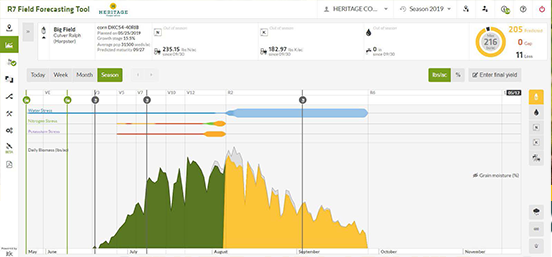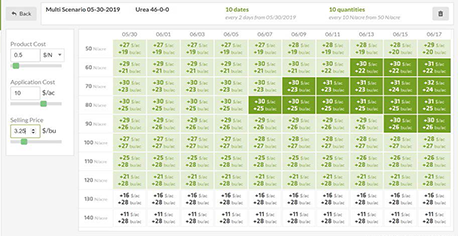A Weight off Your Shoulders: Managing In-Season Inputs
May 18, 2020
Amanda Bahn-Ziegler
Seed District Sales Manager
WinField® United

Have you ever thought to yourself, “Wow, that corn field is looking great – I think I will put some extra nitrogen out there!”. Or maybe, “It’s getting a little late to be planting this longer maturity corn, maybe I should switch it out for something earlier…”. How do you make the final decision about what to do in these situations?
Using emotions to make these decisions can be costly. Heritage Cooperative offers tools, such as R7® Field Forecasting Tool from WinField® United, to help put sound data and agronomics behind these weighty decisions. The R7 Field Forecasting Tool pairs the national WinField United Answer Plot data with your local agronomist’s expertise to help you identify opportunities to optimize yield all season long. This crop model is built to offer solutions for corn, soybeans and wheat.
The R7 Field Forecasting Tool puts together local weather information with your own in-field data and the background research from WinField United to create a “digital twin” of every field that you enroll. This means you can try out that earlier hybrid or higher nitrogen rate in a virtual field and get some additional guidance before you spend any of your valuable input dollars in your own field.
R7 Field Forecasting Tool not only gives you a predicted yield number, but it also tells you about “Gap Bushels” that can be saved/gained through management, and “Lost Bushels” that are not recoverable. With lower commodity prices right now, knowing how many bushels you are really managing for can play a big role in how, when, and where you place your inputs. One of the most popular features in R7 Field Forecasting Tool is the Scenario Builder. See below for an example showing how this feature can help you determine the optimum nitrogen rate and date to achieve the biggest return on your investment.

Here are just a few of questions the Field Forecasting Tool could help answer for you in the 2020 season:
Seed District Sales Manager
WinField® United

Have you ever thought to yourself, “Wow, that corn field is looking great – I think I will put some extra nitrogen out there!”. Or maybe, “It’s getting a little late to be planting this longer maturity corn, maybe I should switch it out for something earlier…”. How do you make the final decision about what to do in these situations?
Using emotions to make these decisions can be costly. Heritage Cooperative offers tools, such as R7® Field Forecasting Tool from WinField® United, to help put sound data and agronomics behind these weighty decisions. The R7 Field Forecasting Tool pairs the national WinField United Answer Plot data with your local agronomist’s expertise to help you identify opportunities to optimize yield all season long. This crop model is built to offer solutions for corn, soybeans and wheat.
The R7 Field Forecasting Tool puts together local weather information with your own in-field data and the background research from WinField United to create a “digital twin” of every field that you enroll. This means you can try out that earlier hybrid or higher nitrogen rate in a virtual field and get some additional guidance before you spend any of your valuable input dollars in your own field.
R7 Field Forecasting Tool not only gives you a predicted yield number, but it also tells you about “Gap Bushels” that can be saved/gained through management, and “Lost Bushels” that are not recoverable. With lower commodity prices right now, knowing how many bushels you are really managing for can play a big role in how, when, and where you place your inputs. One of the most popular features in R7 Field Forecasting Tool is the Scenario Builder. See below for an example showing how this feature can help you determine the optimum nitrogen rate and date to achieve the biggest return on your investment.

Here are just a few of questions the Field Forecasting Tool could help answer for you in the 2020 season:
- Should I switch to an earlier maturity since my planting date has been pushed back?
- How much yield potential is at risk if I push this application back a few days?
- Should I put out some extra late nitrogen in this field?
- Which micronutrients should I put in the tank next time I go across this field?